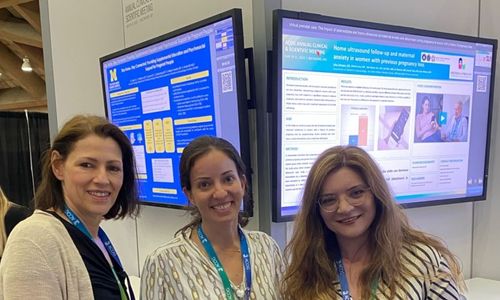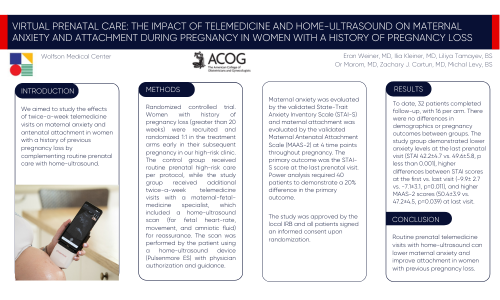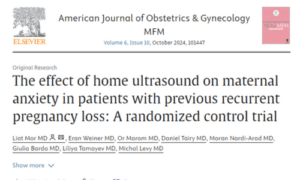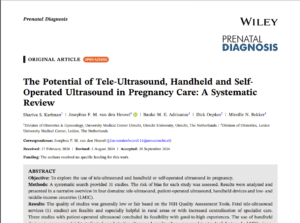Authors:
Eran Weiner, MD, Ilia Kleiner, MD, Liliya Tamayev, BS Or Marom, MD, Zachary J. Cartun, MD, Michal Levy,
Objective:
We aimed to study the effects of twice-a-week telemedicine visits on maternal anxiety and antenatal attachment in women with a history of previous pregnancy loss by complementing routine prenatal care with home-ultrasound.
Methods:
Randomized controlled trial. Women with history of pregnancy loss (greater than 20 weeks) were recruited and randomized 1:1 in the treatment arms early in their subsequent pregnancy in our high-risk clinic. The control group received routine prenatal high-risk care per protocol, while the study group received additional twice-a-week telemedicine visits with a maternal-fetalmedicine specialist, which included a home-ultrasound scan (for fetal heart-rate, movement, and amniotic fluid) for reassurance. The scan was performed by the patient using a home-ultrasound device (Pulsenmore ES) with physician authorization and guidance.
Maternal anxiety was evaluated by the validated State-Trait Anxiety Inventory Scale (STAI-S) and maternal attachment was evaluated by the validated Maternal Antenatal Attachment Scale (MAAS-2) at 4 time points throughout pregnancy. The primary outcome was the STAIS score at the last prenatal visit. Power analysis required 40 patients to demonstrate a 20% difference in the primary outcome. The study was approved by the local IRB and all patients signed an informed consent upon randomization.
Results:
To date, 32 patients completed follow-up, with 16 per arm. There were no differences in demographics or pregnancy outcomes between groups. The study group demonstrated lower anxiety levels at the last prenatal visit (STAI 42.2±4.7 vs. 49.6±5.8, p less than 0.001), higher differences between STAI scores at the first vs. last visit (-9.9± 2.7 vs. -7.1±3.1, p=0.011), and higher MAAS-2 scores (50.4±3.9 vs. 47.2±4.5, p=0.039) at last visit.
Conclusions:
Routine prenatal telemedicine visits with home-ultrasound can lower maternal anxiety and improve attachment in women with previous pregnancy loss.
Presented at: ACOG Americal College of Obstetricians Gynecologists 2023

Poster presentation at ACOG 2023







